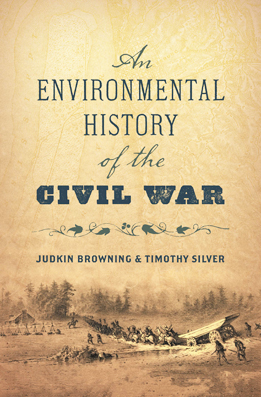|
An Environmental
History of the Civil War
by Judkin Browning & Timothy Silver
c.2020. The University of North Carolina Press
$30 / higher in Canada
260 pages
By Terri Schlichenmeyer
The Truth Contributor
Save the Earth!
You'd agree to that. Who
doesn't want to enjoy a bright, airy afternoon with
cotton-ball clouds? Of course, you'd happily leave
your grandchildren those shirt-sleeve kinds of days,
thunderstorm evenings, clean air and water. That's what
you'd choose if you could – though, as you'll see in
An Environmental History of the Civil War by Judkin
Browning & Timothy Silver, things weren't always so
sunny. |
 |
|
In all the battles that
occurred in the Civil War, just one campaign – the Mud March
of January, 1863 – was named after the weather in which it
happened. It was the result of not having accurate weather
information, leading to poor planning. And it was not the
only time that unforeseen forces affected the war.
The war, say Browning and
Silver, had barely begun when measles outbreaks hit the
newly-formed ranks especially hard. The average soldiers
were boys from rural areas and "rural folk... lacked the
immunity that some city folk enjoyed," so thousands fell
ill. Bacterial infections followed, as did insect-carried
and water-borne diseases; syphilis and gonorrhea spread,
too, their effects lingering well past wars' end.
Hunger was a near-constant
issue that affected soldiers' stamina; on or off the
battlefield, they were not always well-fed. At
least one general ordered his troops "not to confiscate
private property," but hunger was stronger than a need to
obey and foodstores were regularly raided, leaving civilians
to starve. Troops dealt with floods or drought but,
unaccustomed to local weather or ill-prepared by suppliers,
soldiers suffered from heat stroke or severe dehydration
exacerbated by dysentery from drinking water contaminated by
debris, human and animal waste, or by corpses dumped in
water sources or inadequate graves.
These are but a few issues
of environment that happened to soldiers, but the
authors also write about the effects on the environment
from soldiers: fields left stripped and barren, cattle
populations that took decades to recover, entire forests
destroyed, alterations to the land, and countless graves and
trenches dug for those who never went home...
Chances are, if you're a
student of Civil War history, you own shelves and shelves
filled with battle dates and biographies. An
Environmental History of the Civil War moves the story
in a totally different direction.
Here, authors Browning and
Silver take a no-holds-barred approach that goes deep into
parts of the war that affected men on an individual
basis, with a focus that's less on Generals and more on
general troops, and a narrative that extends to both Black
and White. Overall, that information is factual as well as
matter-of-fact but it can be horrifyingly gruesome, too,
with vivid descriptions of wounds and dispassionate images
of violent death.
This, in other words,
probably isn't a book you'd want to take to dinner.
That aside, Civil War
buffs and anyone who's curious about day-to-day details of
history won't be able to resist this thorough,
non-sensational, very fascinating book. An Environmental
History of the Civil War shows that it was a war between
the North and the South, and the Earth, too.
|